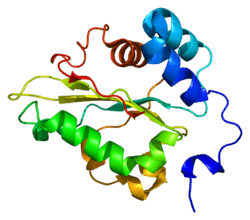EEF1G
| Eukaryotic translation elongation factor 1 gamma | |||||||||||||
|---|---|---|---|---|---|---|---|---|---|---|---|---|---|
 PDB rendering based on 1pbu. | |||||||||||||
| |||||||||||||
| Identifiers | |||||||||||||
| Symbols | EEF1G ; EF1G; GIG35 | ||||||||||||
| External IDs | OMIM: 130593 MGI: 1914410 HomoloGene: 20363 GeneCards: EEF1G Gene | ||||||||||||
| |||||||||||||
| Orthologs | |||||||||||||
| Species | Human | Mouse | |||||||||||
| Entrez | 1937 | 67160 | |||||||||||
| Ensembl | ENSG00000254772 | ENSMUSG00000071644 | |||||||||||
| UniProt | P26641 | Q9D8N0 | |||||||||||
| RefSeq (mRNA) | NM_001404 | NM_026007 | |||||||||||
| RefSeq (protein) | NP_001395 | NP_080283 | |||||||||||
| Location (UCSC) | Chr 11: 62.33 – 62.34 Mb | Chr 19: 8.97 – 8.98 Mb | |||||||||||
| PubMed search | |||||||||||||
Elongation factor 1-gamma is a protein that in humans is encoded by the EEF1G gene.[1][2][3]
Function
This gene encodes a subunit of the elongation factor-1 complex, which is responsible for the enzymatic delivery of aminoacyl tRNAs to the ribosome. This subunit contains an N-terminal glutathione transferase domain, which may be involved in regulating the assembly of multisubunit complexes containing this elongation factor and aminoacyl-tRNA synthetases.[3]
Interactions
EEF1G has been shown to interact with:
References
- ↑ Kumabe T, Sohma Y, Yamamoto T (July 1992). "Human cDNAs encoding elongation factor 1 gamma and the ribosomal protein L19". Nucleic Acids Res 20 (10): 2598. doi:10.1093/nar/20.10.2598. PMC 312399. PMID 1598220.
- ↑ Sanders J, Maassen JA, Möller W (January 1993). "Elongation factor-1 messenger-RNA levels in cultured cells are high compared to tissue and are not drastically affected further by oncogenic transformation". Nucleic Acids Res 20 (22): 5907–10. doi:10.1093/nar/20.22.5907. PMC 334453. PMID 1461723. Vancouver style error (help)
- ↑ 3.0 3.1 "Entrez Gene: EEF1G eukaryotic translation elongation factor 1 gamma".
- ↑ 4.0 4.1 4.2 Stelzl U, Worm U, Lalowski M, Haenig C, Brembeck FH, Goehler H et al. (September 2005). "A human protein-protein interaction network: a resource for annotating the proteome". Cell 122 (6): 957–68. doi:10.1016/j.cell.2005.08.029. PMID 16169070.
- ↑ 5.0 5.1 Rual JF, Venkatesan K, Hao T, Hirozane-Kishikawa T, Dricot A, Li N et al. (October 2005). "Towards a proteome-scale map of the human protein-protein interaction network". Nature 437 (7062): 1173–8. doi:10.1038/nature04209. PMID 16189514.
- ↑ 6.0 6.1 Sang Lee J, Gyu Park S, Park H, Seol W, Lee S, Kim S (February 2002). "Interaction network of human aminoacyl-tRNA synthetases and subunits of elongation factor 1 complex". Biochem. Biophys. Res. Commun. 291 (1): 158–64. doi:10.1006/bbrc.2002.6398. PMID 11829477.
- ↑ Ishii H, Vecchione A, Murakumo Y, Baldassarre G, Numata S, Trapasso F et al. (August 2001). "FEZ1/LZTS1 gene at 8p22 suppresses cancer cell growth and regulates mitosis". Proc. Natl. Acad. Sci. U.S.A. 98 (18): 10374–9. doi:10.1073/pnas.181222898. PMC 56968. PMID 11504921.
Further reading
- Lew Y, Jones DV, Mars WM, Evans D, Byrd D, Frazier ML (1992). "Expression of elongation factor-1 gamma-related sequence in human pancreatic cancer.". Pancreas 7 (2): 144–52. doi:10.1097/00006676-199203000-00003. PMID 1372736.
- Koonin EV, Mushegian AR, Tatusov RL, Altschul SF, Bryant SH, Bork P et al. (1995). "Eukaryotic translation elongation factor 1 gamma contains a glutathione transferase domain--study of a diverse, ancient protein superfamily using motif search and structural modeling.". Protein Sci. 3 (11): 2045–54. doi:10.1002/pro.5560031117. PMC 2142650. PMID 7703850.
- Sheu GT, Traugh JA (1998). "Recombinant subunits of mammalian elongation factor 1 expressed in Escherichia coli. Subunit interactions, elongation activity, and phosphorylation by protein kinase CKII.". J. Biol. Chem. 272 (52): 33290–7. doi:10.1074/jbc.272.52.33290. PMID 9407120.
- Sheu GT, Traugh JA (1999). "A structural model for elongation factor 1 (EF-1) and phosphorylation by protein kinase CKII.". Mol. Cell. Biochem. 191 (1-2): 181–6. doi:10.1023/A:1006802125856. PMID 10094407.
- Kim JE, Kim KH, Lee SW, Seol W, Shiba K, Kim S (2000). "An elongation factor-associating domain is inserted into human cysteinyl-tRNA synthetase by alternative splicing.". Nucleic Acids Res. 28 (15): 2866–72. doi:10.1093/nar/28.15.2866. PMC 102683. PMID 10908348.
- Ishii H, Vecchione A, Murakumo Y, Baldassarre G, Numata S, Trapasso F et al. (2001). "FEZ1/LZTS1 gene at 8p22 suppresses cancer cell growth and regulates mitosis.". Proc. Natl. Acad. Sci. U.S.A. 98 (18): 10374–9. doi:10.1073/pnas.181222898. PMC 56968. PMID 11504921.
- Sang Lee J, Gyu Park S, Park H, Seol W, Lee S, Kim S (2002). "Interaction network of human aminoacyl-tRNA synthetases and subunits of elongation factor 1 complex.". Biochem. Biophys. Res. Commun. 291 (1): 158–64. doi:10.1006/bbrc.2002.6398. PMID 11829477.
- Gevaert K, Goethals M, Martens L, Van Damme J, Staes A, Thomas GR et al. (2004). "Exploring proteomes and analyzing protein processing by mass spectrometric identification of sorted N-terminal peptides.". Nat. Biotechnol. 21 (5): 566–9. doi:10.1038/nbt810. PMID 12665801.
- Vanwetswinkel S, Kriek J, Andersen GR, Dijk J, Siegal G (2004). "1H, 15N and 13C resonance assignments of the highly conserved 19 kDa C-terminal domain from human elongation factor 1Bgamma.". J. Biomol. NMR 26 (2): 189–90. doi:10.1023/A:1023504611632. PMID 12766415.
- Zhang C, Dowd DR, Staal A, Gu C, Lian JB, van Wijnen AJ et al. (2003). "Nuclear coactivator-62 kDa/Ski-interacting protein is a nuclear matrix-associated coactivator that may couple vitamin D receptor-mediated transcription and RNA splicing.". J. Biol. Chem. 278 (37): 35325–36. doi:10.1074/jbc.M305191200. PMID 12840015.
- Colland F, Jacq X, Trouplin V, Mougin C, Groizeleau C, Hamburger A et al. (2004). "Functional proteomics mapping of a human signaling pathway.". Genome Res. 14 (7): 1324–32. doi:10.1101/gr.2334104. PMC 442148. PMID 15231748.
- Jin J, Smith FD, Stark C, Wells CD, Fawcett JP, Kulkarni S et al. (2004). "Proteomic, functional, and domain-based analysis of in vivo 14-3-3 binding proteins involved in cytoskeletal regulation and cellular organization.". Curr. Biol. 14 (16): 1436–50. doi:10.1016/j.cub.2004.07.051. PMID 15324660.
- Goehler H, Lalowski M, Stelzl U, Waelter S, Stroedicke M, Worm U et al. (2004). "A protein interaction network links GIT1, an enhancer of huntingtin aggregation, to Huntington's disease.". Mol. Cell 15 (6): 853–65. doi:10.1016/j.molcel.2004.09.016. PMID 15383276.
- Andersen JS, Lam YW, Leung AK, Ong SE, Lyon CE, Lamond AI et al. (2005). "Nucleolar proteome dynamics.". Nature 433 (7021): 77–83. doi:10.1038/nature03207. PMID 15635413.
| |||||||||
